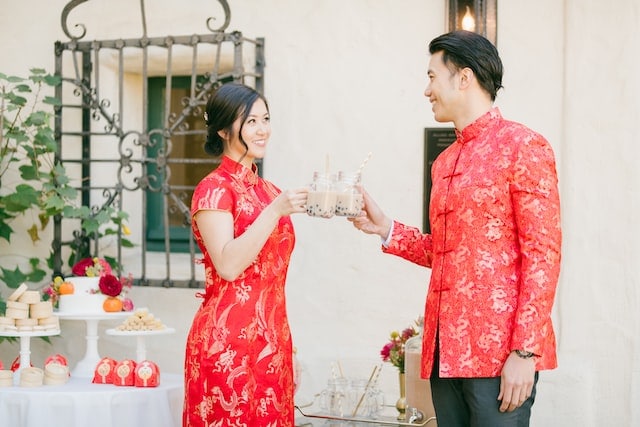
Chinese weddings can be described as a mixture between traditional and modern. Granted, they vary according to the wealth of the newlyweds and their families, but some things are present in every Chinese wedding, such as colors, food, and certain traditions.
So, here’s a list of ten authentic Chinese wedding traditions that you’ll find in pretty much every Chinese wedding.
1. Dowry and Gifts
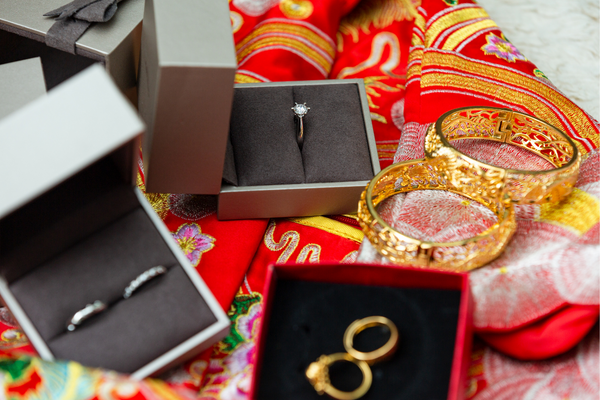
Before the wedding can take place, the groom must offer a series of gifts to his betrothed, lest the bride’s family calls the whole thing off.
Among these “recommended presents,” jewelry made of gold cannot be ignored. Neither can spirits, such as wine or brandy, and more traditionally, dragon and phoenix candles, sesame seeds, and tea leaves.
The gifts are then presented to the bride or directly to her family. These gifts not only symbolize prosperity and good fortune but also act as compensation for the loss of a family member. By accepting these gifts and money, the bride’s family shows acceptance of the groom and his family.
This presentation of gifts is carried out during a ceremony known as Guo Da Li, which includes several ritualized steps such as formulaic compliments to the bride’s family and the bestowing of blessings to the soon-to-be-married couple by the parents from both sides.
The bride’s parents return some of the dowry money to the groom’s family but retain a sizable share of what they refer to as “diaper money”, as a token of gratitude to the bride’s parents for raising her.
2. Wedding Date
Chinese couples spend a lot of time (and money) choosing the perfect date for their wedding ceremony, an event rarely left to chance. Depending on their faith and their place of birth, they will usually leave the complicated task to either a fortune teller, a Feng Shui expert, or a monk.
The couple is very careful about the wedding date because it will have long-lasting consequences on the happiness and success of their marriage. The expert, who decides on a favorable wedding date, will take into account their birthday details, Zodiac signs, and other important information to settle on a date free from bad omens.
3. An Chuang Ceremony
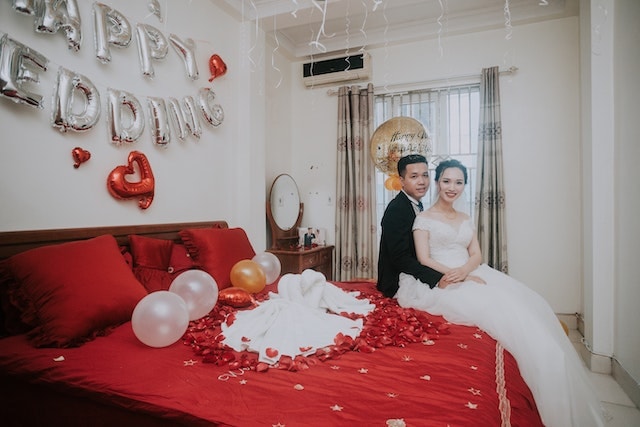
The An Chuang ceremony consists of preparing the matrimonial bed before the wedding. Although it appears to be a simple ceremony, there’s much more to it, as Chinese people believe that how they arrange the matrimonial bed will not only affect the harmony and happiness of the marriage,; but also its fruitfulness and the health and happiness of their offspring.
The An Chuang should be carried out by a female relative, hopefully, someone with good fortune during her marriage. (Blessed with kids and a happy spouse.) This relative will dress the bed in red colored linens and beddings and decorate it with several items such as dried fruit, nuts, and dates. (Symbolizing a fertile and sweet marriage.)
This ritual can be held anytime between three days and a week before the wedding (provided the bed remains as it was during the An Chuang). However, if anyone sleeps on the bed before the couple concludes their wedding, it is said to bring bad luck, resulting in a disastrous marriage.
4. Sending Invitations
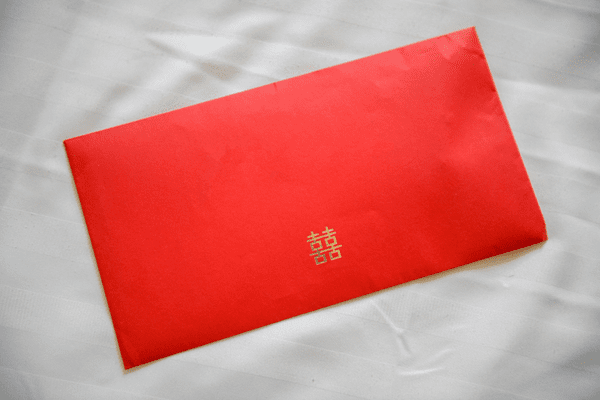
In every formal Chinese wedding invitation card, the Chinese symbol of Shuangxi (translates to double happiness) is printed on the front. This symbol is featured in gold lettering with a red background and is found in almost every formal wedding invitation from China. Sometimes the wedding invitation comes in a red packet containing a souvenir.
The invitation covers all the necessary details about the wedding, such as the couple’s (and sometimes, parents) names, the dates and venues for the wedding, banquet, the cocktail reception, and the actual dinner.
Information that non-Chinese people may find redundant (but is actually essential for Chinese tradition), such as the couple’s Zodiac signs and birthdays, also manage to make their way into the invitation.
5. Hair Combing Ceremony
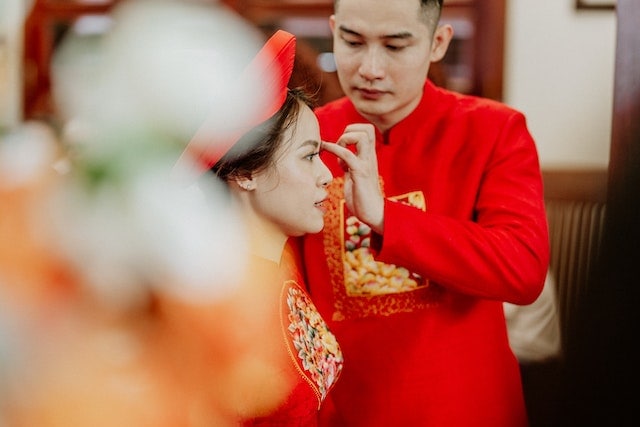
A perfect example of something that in the Western world, is usually regarded as purely cosmetic but in Chinese folklore, is considered highly symbolic is the hair combing ceremony.
The hair-combing ceremony is performed the night before the wedding and symbolizes the road to adulthood. First, the couple must shower separately with grapefruit leaves to ward off bad spirits, and afterward change into brand-new red-colored clothes and slippers. Then, they can sit together and get their hair combed.
While the bride must face a mirror or a window, the groom must face the inside of the house due to Feng Shui reasons. Then their respective parents prepare several ritual items such as red candles, a hair comb, a stick of incense, a ruler, and cypress leaves, wherein the ceremony can begin.
The ceremony is carried out by a woman of good fortune who will sing for good luck while combing the hair of the bride or groom. The ceremony ends after their hair has been combed four times and adorned with cypress leaves.
6. Wedding Colors
As it’s probably apparent by now, red and gold are the predominant colors in all Chinese wedding decorations. It is due to the color red being associated with love, success, happiness, luck, honor, loyalty, and prosperity, while gold is naturally linked to material wealth.
Apart from that, a lot of symbols are also used. One of the most heavily featured in Chinese weddings is the Shuangxi, composed of two identical characters that mean double happiness (Xi). Other important symbols include dragons, phoenixes, and mandarin ducks.
7. Picking Up the Bride
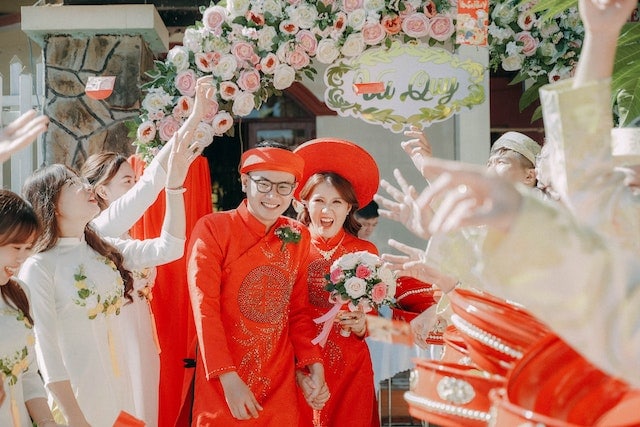
In past centuries, the “picking up of the bride” typically involved a large procession that featured all the local villagers.
Nowadays, while clearly smaller in scale, the procession involves a lot of noise with the help of firecrackers, drums, and gongs. Everyone in the near vicinity is duly reminded that there is a woman who is about to get married there.
Also, the modern procession involves professional dancers and children to symbolize fertility.
8. The Chuangmen Test
On the day of the wedding, games are played with the intention of “testing” the groom’s determination to marry the bride.
Chuangmen, or “door games,” are based on the assumption that the bride is a valuable prize, and she should not be handed out to the groom so easily. Hence, he has to undergo a number of tasks, and if he proves his worth, the bridesmaids will agree to “surrender” the bride to him.
Chuangmen are typically fun and sometimes challenging for the groom. Most often, these include personal questions about the bride (to prove he knows her very well), having his legs waxed by the bridesmaids, eating different types of foods, and putting his feet inside a large bucket of ice water.
9. The Tea Ceremony
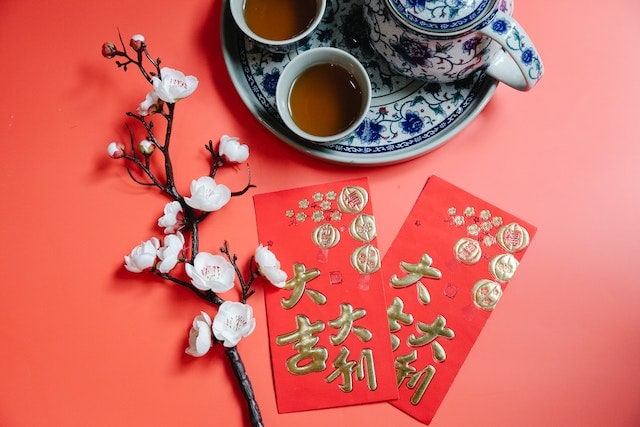
No Chinese tradition is complete without a tea ceremony. In the particular case of weddings, the couple will kneel and serve tea to the parents and relatives of both families. The couple starts with the groom’s family, then the bride’s.
Throughout the ceremony (typically after each sip of tea), members of both families will hand the couple red envelopes that include money and jewelry and bless the couple, welcoming them to their respective families.
After the groom’s parents have been served, the couple will present tea to the oldest members of the family, most often, the grandparents or great-grandparents, moving into uncles and aunts and concluding with unmarried cousins, siblings, and youngsters. After this, the same rule is followed for the bride’s family.
10. The Wedding Banquet
It is the responsibility of the parents on both sides to host the wedding banquet on the night of the wedding ceremony.
It typically consists of eight courses, each one with a different symbolic meaning associated. For instance, there has to be a fish course symbolizing abundance, a suckling pig to represent the purity of the bride, a dish with duck for peace, and a green dessert symbolizing fertility.
Nowadays, it is common to see a slideshow of photographs of the couple displayed on the walls during the banquet. Also, the banquet would not be complete without the noisy yam seng toast to wish the couple happiness and fertility.
Wrapping Up
Giving away a daughter in marriage is not easy in any part of the world. In Chinese weddings, the groom must really fight for the right to her hand. He must undergo a series of (sometimes painful) tasks and tests, prove his worth by picking her up and treating her right, and compensate her family with money and gifts.
This, added to a series of strict rituals, will ensure they have a long and happy marriage.
While Chinese wedding customs and traditions are changing to suit modern times, many of these are highly symbolic and are still carried out. Check out our articles on 10 Jewish wedding traditions to find out about more unique and interesting customs.








